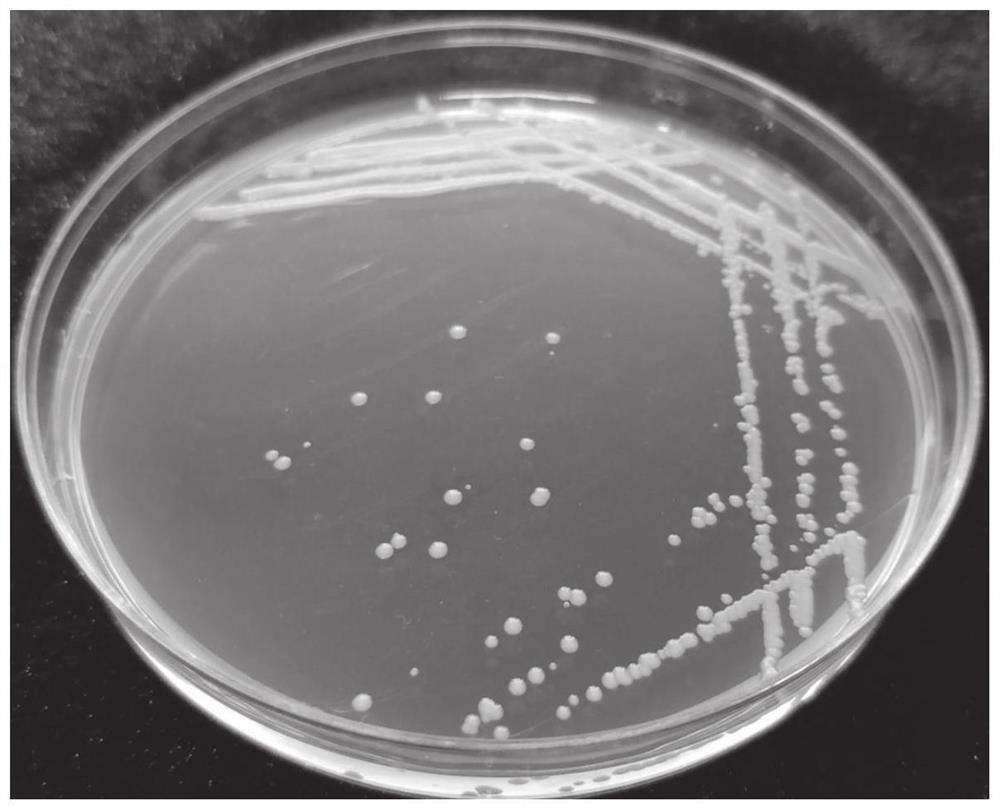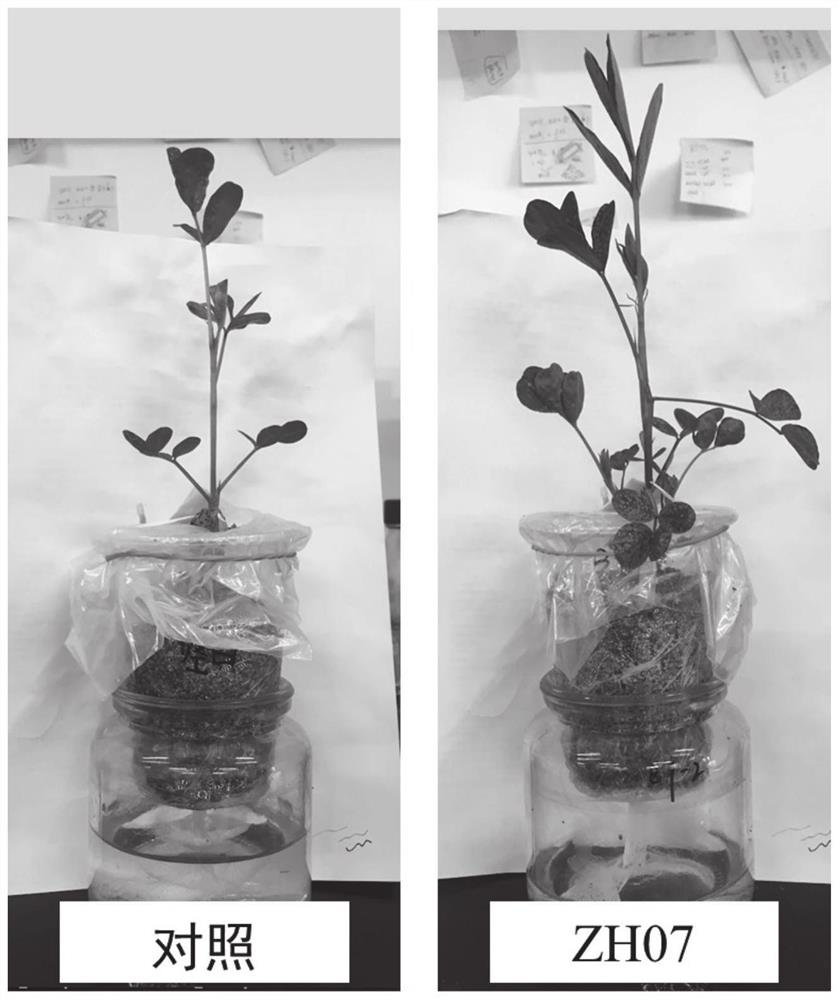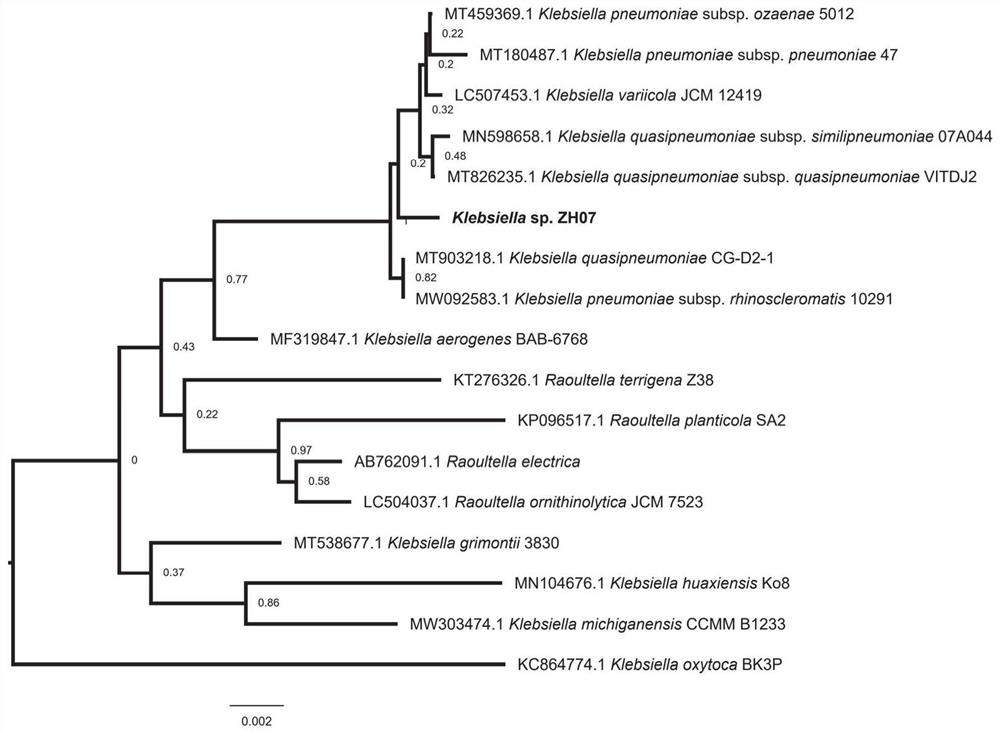A rhizosphere probiotic strain Klebsiella zh07 and its application
A Klebsiella, ZH07 technology, applied in the field of microorganisms, can solve the problems affecting seed germination, plant growth, peanut production reduction, etc.
- Summary
- Abstract
- Description
- Claims
- Application Information
AI Technical Summary
Problems solved by technology
Method used
Image
Examples
Embodiment 1
[0025] Example 1: Isolation and identification of microorganisms degrading peanut autotoxic substances
[0026] The isolation of microorganisms degrading peanut autotoxic substances mainly includes four parts: enrichment, selective culture, purification and domestication.
[0027] (1) Enrichment
[0028] Obtain the soil of continuous cropping peanuts in saline-alkali land for ten years, directly inoculate 1g of peanut soil into 100ml of inorganic salt medium containing 1g / L benzoic acid, shake at 30°C and 160r / min. In this way, the strains capable of degrading benzoic acid can be enriched, which is convenient for subsequent selective cultivation and purification. Similarly, microorganisms that use p-hydroxybenzoic acid, salicylic acid, cinnamic acid, vanillic acid and coumaric acid as the only carbon source can be enriched. The experiment uses inorganic salt medium, the composition includes (NH 4 ) 2 SO 4 2g / L, KH 2 PO 4 2g / L, Na 2 HPO 4 1.3g / L, carbon source 1g / L, ...
Embodiment 2
[0048] Embodiment 2: Determination of the degradation rate of peanut autotoxic substances
[0049] The degradation rate was determined by taking six kinds of autotoxic substances as the sole carbon source, absorbing 10 μL of the strains in the -80 °C refrigerator and adding them to 5 mL of LB liquid medium for activation, and culturing them on a shaker at 37 °C for 12 hours to complete the activation. Adjust OD with LB medium 600 to 0.5, take 1mL OD 600 The bacterial solution with a concentration of 0.5 was added to 49 mL of inorganic salt culture solution (1 mL of sterile water was added for the control), and the corresponding autotoxic substance was used as the only carbon source in the culture solution at a concentration of 5 g / L, and cultured on a shaking table at 37°C. Taking LB liquid medium as a control, take 1mL culture medium every 12h to measure OD 600 The value is taken as the relative number of degrading bacteria proliferation. Take another small amount of bacte...
Embodiment 3
[0055] Embodiment 3: Determination of promoting growth of rhizosphere probiotics to peanut growth
[0056] Greenhouse pot experiments were used to verify the ability of Klebsiella ZH07 to promote peanut growth.
[0057] The ratio of nutrient solution is as follows (1L): ferric citrate 0.075g, Ca(NO3) 2 0.03g, KCL 0.075g, MgSO 4 ·7H 2 O 0.06g, K 2 HPO 4 0.136g, CaSO 4 0.46g, trace elements 1mL.
[0058] The ratio of trace elements is as follows (1L): H 3 BO 3 2.86g, MnSO 4 1.81g, CuSO 4 ·5H 2 O 0.8g, ZnSO 4 0.22g, H 2 MoO 4 0.02g.
[0059] Disinfect peanut seeds with 0.1% sodium hypochlorite solution for 10 min, and then rinse the seeds with sterile water three times. The washed seeds were soaked in sterile water for 10 hours to fully absorb water. Mix the nutrient solution into the sterilized vermiculite to reach a wet state, then divide it into plastic cups, about 100g per cup, put a peanut seed in the middle of the vermiculite, and uniformly adjust the ...
PUM
 Login to View More
Login to View More Abstract
Description
Claims
Application Information
 Login to View More
Login to View More - R&D
- Intellectual Property
- Life Sciences
- Materials
- Tech Scout
- Unparalleled Data Quality
- Higher Quality Content
- 60% Fewer Hallucinations
Browse by: Latest US Patents, China's latest patents, Technical Efficacy Thesaurus, Application Domain, Technology Topic, Popular Technical Reports.
© 2025 PatSnap. All rights reserved.Legal|Privacy policy|Modern Slavery Act Transparency Statement|Sitemap|About US| Contact US: help@patsnap.com



